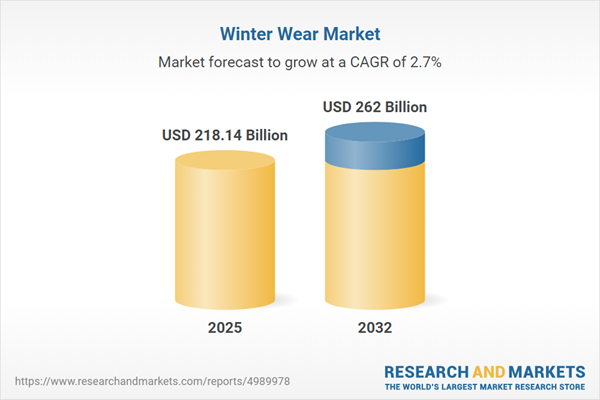Speak directly to the analyst to clarify any post sales queries you may have.
The winter wear market is evolving rapidly as shifting consumer values, climate unpredictability, and new supply chain realities realign global demand and competitive positioning. Senior decision-makers require actionable insight to anticipate, adapt, and seize opportunity in this complex landscape.
Market Snapshot: Current Performance and Projected Growth
The winter wear market grew from USD 212.49 billion in 2024 to USD 218.14 billion in 2025. It is projected to expand further at a CAGR of 2.65%, and by 2032, the industry is expected to reach USD 262.00 billion. This stable upward trajectory underscores both resilience and the surging importance of adaptive strategies as consumer preferences shift and external factors drive sector realignment.Scope & Segmentation: Comprehensive Insights into Market Complexity
- Product Types: Boots, Gloves, Hats & Scarves, Jackets & Coats, Thermal Wear. Specific subcategories assessed include Fashion Boots, Hiking Boots, Snow Boots, Knit Gloves, Leather Gloves, Waterproof Gloves, Balaclavas, Beanies, Scarves, Down Jackets, Leather Jackets, Parkas, Softshell Jackets, Thermal Bottoms, Thermal Tops, and Thermals Set.
- Material: Down, Fleece, Leather, Nylon, Polyester, Wool. Each material offers unique performance profiles, with consumer expectations shaping procurement and brand communications.
- Distribution Channels: Department Stores, Specialty Stores, Supermarkets, Brand Websites, E Commerce Platforms, and Online Marketplaces. Customer journeys integrate digital touchpoints and curated offline experiences.
- End Users: Men, Women. Targeted segmentation enables tailored design, sizing, and marketing strategies.
- Regional Coverage:
- Americas: United States, Canada, Mexico, Brazil, Argentina, Chile, Colombia, Peru
- Europe, Middle East & Africa: United Kingdom, Germany, France, Russia, Italy, Spain, Netherlands, Sweden, Poland, Switzerland, United Arab Emirates, Saudi Arabia, Qatar, Turkey, Israel, South Africa, Nigeria, Egypt, Kenya
- Asia-Pacific: China, India, Japan, Australia, South Korea, Indonesia, Thailand, Malaysia, Singapore, Taiwan
- Company Benchmarking: Key players assessed include VF Corporation, Columbia Sportswear Company, Decathlon S.A., Canada Goose Holdings Inc., Moncler S.p.A., Fast Retailing Co., Ltd., H&M Hennes & Mauritz AB, Adidas AG, Nike, Inc., Under Armour, Inc.
Key Takeaways: Strategic Insights for Winter Wear Market Leaders
- Rising environmental awareness is driving investment in recycled materials, such as plant-based insulation and responsibly sourced down, influencing product innovation roadmaps.
- Consumer demand is shifting toward adaptable, high-performance textiles that address both technical performance and sustainability, encouraging closer integration between design and supply chain teams.
- Omnichannel strategies are key to meeting evolving engagement expectations, with brands leveraging immersive digital platforms alongside brick-and-mortar presence to optimize reach and conversion.
- Regional distinction matters; North America focuses on performance outerwear, while EMEA navigates stricter regulations and Asia-Pacific leans on technology-driven features and robust e-commerce ecosystems.
- Emerging direct-to-consumer brands and hybrid retailers are intensifying competition by enabling rapid product iteration, customer personalization, and accelerated delivery models.
- Collaborative partnerships—both within the supply chain and with external technology providers—are essential for agility, responsiveness, and differentiation.
Tariff Impact: Navigating US Market Disruption
Recent US trade tariffs on selected texts and finished goods have increased production costs and placed upward pressure on winter apparel prices. Manufacturers are reassessing supply chain strategy, balancing nearshoring with diversification across new regions. Inventory models and retail pricing are undergoing scrutiny, prompting brands to rethink sourcing and explore regional partnerships to limit tariff exposure and protect operational margins.
Methodology & Data Sources
This report’s intelligence is underpinned by a blend of primary and secondary data. Field research involved executive interviews, retailer surveys, and consumer focus groups. A thorough review of industry reports, trade publications, official regulatory filings, and proprietary market databases was conducted. Data triangulation and validation workshops ensured robust, consensus-driven conclusions.
Why This Report Matters: Empowering C-Suite Strategy
- Delivers a unified, actionable view of global winter wear industry shifts, segmented by category, channel, and region, equipping teams to prioritize growth opportunities and investment.
- Identifies critical headwinds, including supply chain, regulatory, and tariff challenges, with practical recommendations for risk mitigation and agile response.
- Benchmarks innovation and competitive positioning among leading and emerging brands, informing long-term planning and partnership decisions.
Conclusion
This report equips winter wear market decision-makers with informed perspectives to realize strategic advantage amid ongoing market transformation. Leverage these insights to shape resilient, forward-facing strategies in a changing global landscape.
Additional Product Information:
- Purchase of this report includes 1 year online access with quarterly updates.
- This report can be updated on request. Please contact our Customer Experience team using the Ask a Question widget on our website.
Table of Contents
3. Executive Summary
4. Market Overview
7. Cumulative Impact of Artificial Intelligence 2025
List of Figures
Samples

LOADING...
Companies Mentioned
The key companies profiled in this Winter Wear market report include:- VF Corporation
- Columbia Sportswear Company
- Decathlon S.A.
- Canada Goose Holdings Inc.
- Moncler S.p.A.
- Fast Retailing Co., Ltd.
- H&M Hennes & Mauritz AB
- Adidas AG
- Nike, Inc.
- Under Armour, Inc.
Table Information
| Report Attribute | Details |
|---|---|
| No. of Pages | 181 |
| Published | October 2025 |
| Forecast Period | 2025 - 2032 |
| Estimated Market Value ( USD | $ 218.14 Billion |
| Forecasted Market Value ( USD | $ 262 Billion |
| Compound Annual Growth Rate | 2.6% |
| Regions Covered | Global |
| No. of Companies Mentioned | 11 |









